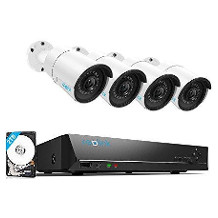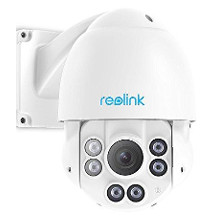Security camera purchasing advice: how to choose the right product
- What you need to know
- With a security camera, you always have an eye on your flat, house, property, or business premises.
- An easily noticeable security camera acts as a deterrent and thus prevents burglaries and damage to property.
- Modern cameras can transmit live images and store recordings. Some devices can be checked from a computer, smartphone, and tablet or even controlled remotely.
- The use of security cameras is limited by legal regulations.
Effectively counter burglaries
The concern about one’s own home is quite justified. According to Statista, there were 266,283 police recorded burglary offences in England and Wales in 2021/2022. This means about 730 burglaries a day. Although the number of cases is on a steadily declining path over the last 20 years, it’s still very high. These offences significantly affect the people’s sense of security. Aside from material losses, after a break-in into their private spaces, many people also struggle with psychological consequences. The fear of a possible subsequent burglary or an encounter with the perpetrator is an additional burden for those affected.
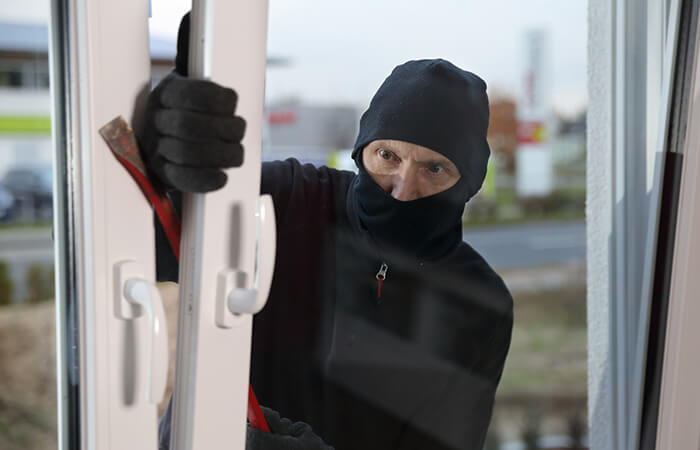
Security cameras serve as a deterrent and help to reconstruct the crime
A security camera is a video camera, with which you can permanently monitor a place, such as a residential building or simply a house entrance. The recorded image can be transmitted live to a monitor or recorded for later evaluation.
The very presence of such a camera can cause burglars to abandon their plans. And if something does happen, the recorded images can help the police solve the crime.
With a security camera, you can always check who’s entering your property. On top of that, these watchful electronic eyes can help to raise the inhibition threshold with regard to vandalism and other crimes. That’s why, security cameras are particularly popular for deterring burglars and keeping them from entering your property.
In addition, security cameras are of particular interest to retailers: compared to a shop detective or security guard, they are cheaper to purchase and operate. What’s more, they can work 24/7 without a break.
Advantages
- The mere presence of a security camera has a deterrent effect on potential offenders.
- Recordings can be used to solve the crime later.
- For retailers and other businesses, they’re cheaper than a shop detective, security guard, or guard dog.
- Video cameras can record 24/7.
Legal situation in the UK
When using a security camera, the following rules should be observed: In general, only your own property or real estate may be monitored by CCTV. Recording of public paths or facilities is not permitted. In this case, the personal privacy rights of passers-by outweigh the need for protection of the property owner.
Domestic CCTV systems
The Information Commissioner’s Office (ICO), which is the UK’s independent regulator for data protection, has provided guidance on the use of CCTV for domestic purposes. According to the ICO, homeowners are generally allowed to install CCTV cameras on their own property, as long as they comply with data protection laws. However, if your domestic CCTV captures images or audio recordings from outside your property boundaries, you should keep the following rules in mind:
- tell people that you’re using CCTV or sound recording,
- provide people with the recordings that have been made of them if they ask for it,
- delete the footage on a regular basis,
- delete recordings of people if they ask you to,
- stop recording a person if they ask you to.
When must the images be deleted
There is no exact amount of time stated in the laws concerning domestic CCTV on when you have to delete your recordings. Nevertheless, you should only keep them for a reasonable amount of time and regularly delete them.
Other regulations
Make sure that the time stamp and day are correct on your footage, as it might be difficult to use it as evidence if this data is not accurate. You don’t have to register your domestic CCTV with the ICO or other institutions.
CCTV installation at your commercial property
The legal situation regarding the use of video surveillance at your commercial property is similar to the domestic use. For obvious reasons, you must adhere to the data protection law too, but you’re also required to put up a sign to let people know that you’re using video surveillance and why, grant access to anyone you have filmed within one month, grant access to the footage to the authorities, e.g., the police if they request it, store recordings only as long as you really need them, pay a data protection fee.
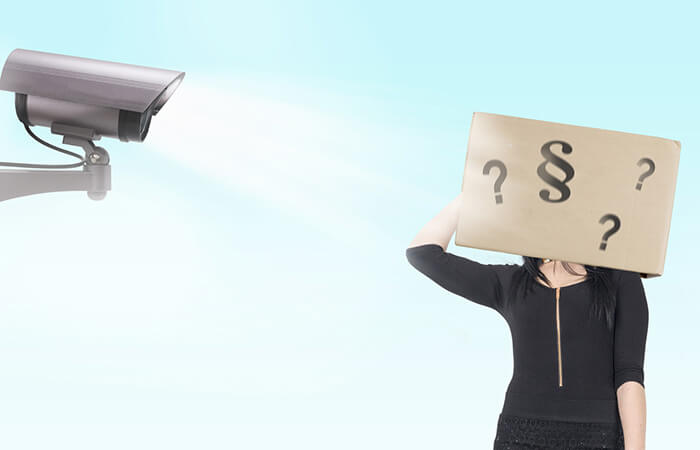
Do not upload images to the internet without authorization
Under no circumstances should you post pictures or videos of a crime on the internet in the hope of receiving tips from the public. Private search appeals encroach on the general right of personality of the perpetrators. Claims for damages can be the consequence. In addition, the perpetrators can demand that you remove the footage from the internet. Instead, you should hand over the footage to the police.
Purchase criteria
Security cameras are available in many different versions, with many different functions and for many different applications. It is therefore not surprising that the price range is huge. It ranges from about $30 to $2000. There are various purchase criteria, which concern the design and the built-in technology. If private living space is to be monitored, for instance, the visual appearance plays a decisive role. Tilting, on the other hand, is not so relevant. Since flush mounting cables is cumbersome and cable ducts are out of the question for aesthetic reasons, you’re best advised to use a wireless IP camera. For businesses, other criteria such as outdoor features can also play a role in the purchase decision.
Conspicuousness
The right camera size depends on the intended use. For the surveillance of the living room, a discrete model is preferable for most users. For outdoor burglary protection, the camera can be a little more noticeable, and signs on windows and doors could also contribute to further deterrence. Cameras used outdoors should also have a certain degree of weather resistance. The IP code provides information on this. A good choice is a camera with IP 65, even better are IP 66 and IP 67.
Buying security cameras in a set
If several cameras are required for video surveillance in order to monitor all rooms of a house or an outdoor area in its entirety, it often makes sense to buy a camera set. This is usually cheaper than buying them individually. It also ensures that all components are compatible with each other. In many cases, the necessary accessories, such as power or network cables, are already included in these sets. The number of cameras in a set varies though.
Image quality
The quality of the recorded images or video sequences determines how many details you can later recognize on the video. In general, a high resolution is preferable. Possible scenarios: Someone turns around their car in your driveway and hits a car parked there. Or someone tampers with the front door, pries it open and steals money or property from the house. In these cases, it would be very annoying if the number plate of the vehicle or the face of the intruder could not be recognized. Various factors have an influence on the image quality.
Resolution: higher is better
Classic security cameras with analogue signal transmission often have a comparatively low resolution. The old analogue PAL standard, which older readers may be familiar with from the tube televisions, resolves at a mere 720 x 576 pixels. This is sufficient for rough surveillance, for example when the user wants to keep an eye on his pets, and it is not important to see every detail. However, the image is too coarse-grained for the evaluation of number plates or faces that are not directly in front of the lens.
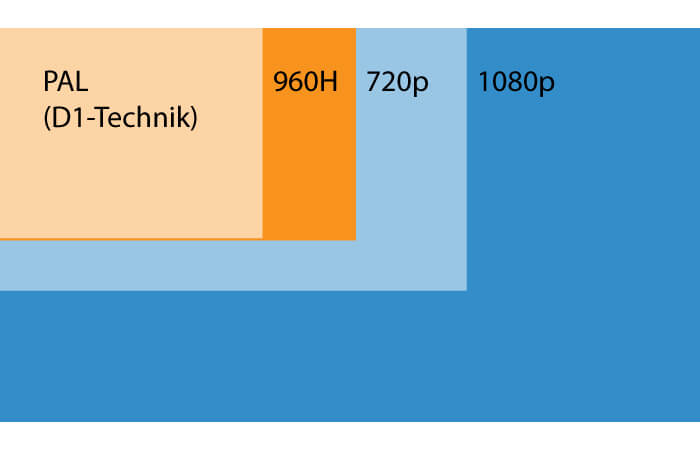
Despite the unstoppable advances of digitalization, a few years ago there was also a technical improvement for analogue cameras: newer cameras with analogue technology have now about 130,000 pixels more. This doesn’t come close to the quality of digital models, but it does make it easier to recognize image details. This type of camera is not suitable for private users, but is mainly used in supermarkets.
Resolution of digital camera systems
Modern, digital camera systems for domestic use have a minimum resolution of 720p. This corresponds to the resolution of HD-ready TVs with 1,280 x 720 pixels. This is sufficient for easily identifying people and objects in the camera’s field of view. If you use a camera with full HD resolution, even small details are visible that would only appear sharp by zooming in on devices with fewer pixels. In terms of price, there are no big differences anymore. For this reason, you should always select the highest possible resolution, provided that the storage space allows this. This is because the higher the resolution, the more storage space is required. Minimum should be 720p for both private and business users. More, however, is always better: If possible, both groups should resort to cameras that support 1,080p.
| Resolution standard | Transmission technology | Number of pixels |
| PAL | analogue | 720 x 576 |
| 960H | analogue | 976 x 582 |
| 720p | digital | 1,280 x 720 |
| 1.080p | digital | 1,920 x 1,080 |
Range differs especially at night
The various camera models also differ in terms of the maximum range they can cover. This doesn’t refer the maximum zoom level; most cameras observe a fixed spot without enlarging it during recording. Instead, maximum range refers to use in dark rooms or at night. In order to record even in complete darkness, an infrared light source is necessary. Nowadays, infrared LEDs are standard and even conserve battery power during prolonged operation. A decisive factor is the range of this light, as the size of the area that can be “illuminated” by the camera depends on it. Areas outside this coverage appear black in the video — comparable to an area outside the light cone of a torch. Therefore, this aspect is also relevant for parents who want to watch their baby sleep on a baby monitor with video.
Infrared light
Infrared light is understood to be a specific spectrum of electromagnetic waves. Infrared LEDs work with a wavelength between 700 and 1000 nanometers. The emitted light is invisible to the human eye, but can be captured by a camera lens. In this way, conclusive images are captured even in complete darkness. They can later be watched in black-and-white.
Motion and face detection
Motion detection ensures that the camera is not recording permanently but only when a person enters the camera’s field of vision which is detected via sensors. This results in small video sequences and eliminates the tedious search through hours of footage. Some models notify you via SMS, email, or push message when an activity is registered and give you access to live images. Cameras that have face recognition go one step further. You “feed” them with pictures of faces belonging to people who you blacklisted or whitelisted. If an unauthorized person (someone who is not on the whitelist) enters the monitored area, the camera informs you. Either only images or video sequences are recorded when a person enters the surveillance area. Another method is to permanently film and set markers so that authorities can jump directly to relevant parts of the video.
Viewing angle decides the image section
The size of the image section depends on the viewing angle. Although only a small section is visible with a low viewing angle of about 30 degrees, with 60 degree a larger edge area is filmed. The latter is the right choice for the vast majority of users. At larger viewing angles of about 180 degrees, the fisheye effect sets in: Although the lens can then cover a complete field of view, there is too much distortion, which means that only objects in the immediate vicinity can be recognized.
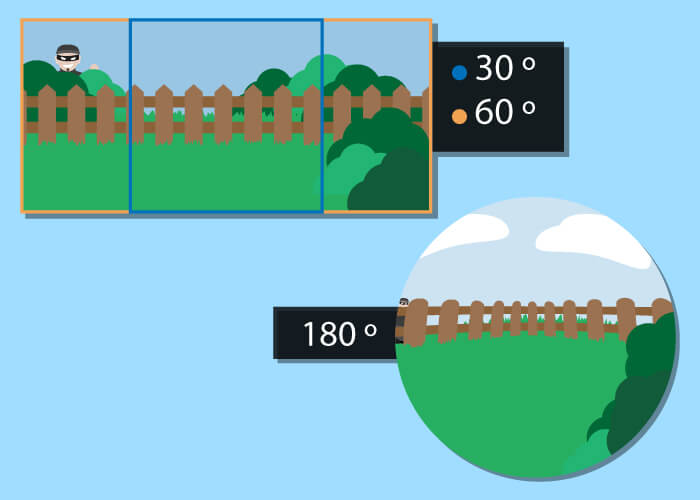
Speaker and microphone allow interaction
A few models have their own speakers or allow external speakers to be connected. They allow live interaction with the persons monitored. For example, burglars can be addressed directly, which may cause them to abandon their plan. In many cases, a microphone is also built into the camera. This allows you to also hear what sounds are occurring in the monitored area. This makes sense when monitoring small children, for example: when parents hear their child crying, they can calm it down remotely if they cannot or do not want to go into the child’s room at the moment. Caution: permanent video or sound recordings and spying on people without their consent or knowledge are prohibited.
Smartphone app
You can control modern IP cameras conveniently and from anywhere via smartphone, tablet, etc. For example, you can switch the alarm function on or off, take photos, stream live videos, or view previously recorded files. For camera models with microphone and loudspeaker, you can use a mobile device as an intercom.

Type and duration of recording
The images and recordings of a security camera can either be saved locally on the device on an SD or microSD card, or stored via a network connection, either on a hard disk in the home network or in a cloud data storage. The first method is usually the easier. The storage medium is either already included, or you can buy it separately. As soon as you have inserted it into the camera, you can save your pictures and recordings on it. If you prefer to save what you’ve recorded on your computer, you have to put up with a little more effort. The advantage: If the camera is damaged by vandalism, the data will still be preserved. Alternatively, it is possible to store the images and recordings in a cloud. Then, you don’t need an extra computer to store your data. Instead, the data ends up in a cloud storage. The data is protected against loss and can be accessed worldwide. Some security cameras include a cloud rate, with other models you book an additional rate. You do not need your own computer; the service provider also takes care of the data backup. The important thing is to secure the cloud access with a secure password.
Power supply
Most devices are powered by the mains, but there are also devices on the market with permanently installed or replaceable batteries. However, the battery-powered models are only suitable for short-term security measures: with continuous recording, the battery sometimes runs out after only one day of operation and must be replaced or recharged. Cameras that only record individual images naturally last longer. Battery-operated models should only be used where there is no power supply nearby. This could be, for example, a private property in a forest. Otherwise, models with a mains plug are recommended, as here an unlimited operating time is possible, provided that the loop mode is activated or the memory is not full.
Different types of security cameras
Depending on the intended use, different types of security cameras are suitable: Simple mini cameras are usually sufficient for small rooms. Larger areas are best covered with a dome or PTZ camera. Robust and weatherproof models are recommended for outdoor use. Let’s have a look at the differences.
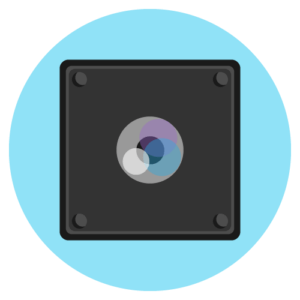
Mini camera
Mini cameras are very compact camera models that can be used to create still images and videos. This category covers ordinary compact models the size of a webcam, but there are also some fancier options. With stealth mini cameras, the lens is particularly small. Their diameter is sometimes only a few millimeters. Some models are offered disguised and built into ballpoint pens, USB sticks, or wall clocks. But beware: Spying on people with these devices is prohibited under penalty (unless the people recorded were informed about the use beforehand). The full-size units are suitable for monitoring pets or small children indoors, for example. For business premises, covert surveillance methods are also allowed, provided that the presence of video surveillance has been clearly indicated at the entrance.
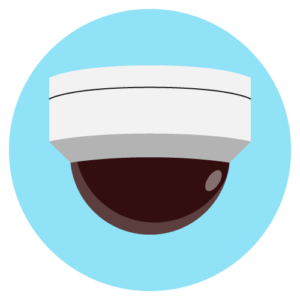
Dome camera
A dome camera is a type of security camera that is housed in a plastic dome. These vandalism-proof systems are primarily used in public spaces. Frequent places of installation are heavily frequented and crime-prone places, streets, and buildings, such as inner-city squares, banks, railway stations, and public transport. But you’ll probably know these models mainly from supermarkets or drug stores. Retailers use them as a deterrent and to solve crimes. The dome is opaque, so it is not possible to see which way the camera inside is facing. This increases the deterrent effect.
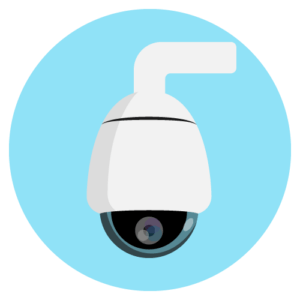
PTZ camera
A PTZ camera is a special form of dome camera that can zoom, tilt, and pan. These models are usually slightly larger than conventional dome cameras and display images in a higher resolution. Even more distant objects become visible through the zoom lens. These camera models, which can be controlled individually, are not exactly designed for private use. With them, you can cover areas that would normally require several cameras with just one device. They are controlled either by joystick or directly via the computer mouse. With all their functions, they are primarily suitable for business premises, factory buildings, or public places that are monitored by security companies. They pan and tilt the cameras to keep an eye on the entire environment and detect suspicious activity. Private users who want to monitor their house or property are more likely to go for a mini or outdoor model.
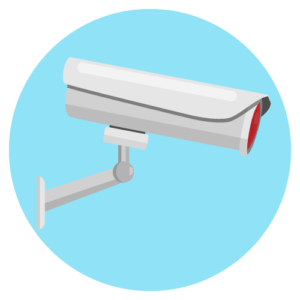
Outdoor camera
Most people know outdoor security cameras from public spaces. They have an elongated design and often a robust housing made of hard plastic or metal. The advantage of such a model is that most people recognize the design, which is also symbolically implemented on warning signs and draws attention to the video recording. This serves as a deterrent. These models are used to monitor outdoor areas, but are not suitable for indoor use due to their size and obtrusive appearance. One disadvantage of rigid models is that the area covered is relatively easy to identify. This might make it possible for a burglar to enter unnoticed through a blind spot. Therefore, it may be necessary to use several cameras to completely cover a target area. A big advantage of these camera models is their high weather resistance. Many models comply with an IP code that indicates how well the camera is protected against water and dust ingression. Some models are also suitable for recording in the dark thanks to infrared LEDs.
Infrared LEDs
Infrared light illuminates the field of view of the camera lens using wavelength ranges between 800 and 1000 nanometers that are invisible to the human eye. Accordingly, the camera is able to record black and white images visible to the human eye even in complete darkness. However, this technique also has a disadvantage: Outsiders would also be able to recognize the camera in the dark because the infrared technology unveils blue or red dots when people look head-on into the camera. Such models are suitable for home and business owners who want to monitor an outdoor area.
The IP codes indicate the suitability of electrical equipment for various environmental conditions. The first number indicates the protection against hazardous parts and the ingress of solid foreign objects, the second number describes the degree of protection against water. But caution: The IP in IP camera stands for Internet Protocol and should not be confused with the IP in IP code, which indicates Ingress Protection of electronic devices against external influences such as dust and moisture.
| Protection code | Qualities |
| IP 65 | dust-tight, complete protection against contact, protection against water jets from any angle |
| IP 66 | dust-tight, complete protection against contact, protection against powerful water jets |
| IP 67 | dust-tight, complete protection against contact, protection against temporary immersion into water |
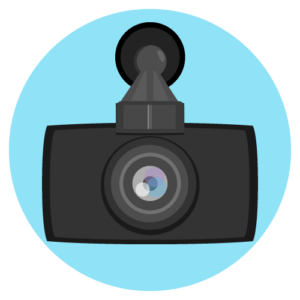
Dashcams
Dashcams are small video cameras that are mounted in the car and monitor the traffic situation. Strictly speaking, they don’t fit into the category of security cameras, but they can well be seen as a special case. These devices permanently record what happens on the road from the moment of activation. If there is no incident, such as emergency braking or a car accident, the video data is temporarily stored for about three minutes and then overwritten. If, on the other hand, one of the aforementioned events takes place, the corresponding sequence is automatically stored in read-only mode on a storage medium, usually an SD card. This is known as a loop recording. Footage of accidents can later help to clarify liability issues and thus prevent problems with the insurance company.
How a security camera works
A security camera is a video camera that comes in different sizes and designs. The classics are analogue or digital cameras with a wall mount, which are installed in shops, for example, to prevent shoplifting or to identify the perpetrator after the act. Because of their deterrent effect on shoplifters, they are often conspicuously designed.
Classic analogue cameras without network connectivity
With these security camera models, the signal is transmitted directly to a monitor and sometimes additionally stored on a data carrier such as a videotape. Digital video data is often also stored on hard disks. To counteract a lack of storage space, these often work according to the so-called loop method. In most cases, these cameras are wired to the receiving device. This requires some extra work depending on the type of installation (surface-mounted or flush-mounted). In some cases, however, wireless transmission is also possible. Although the lack of internet access which also results in the need for a physical storage medium can be rather disadvantageous, there are still reasons to opt for such models:
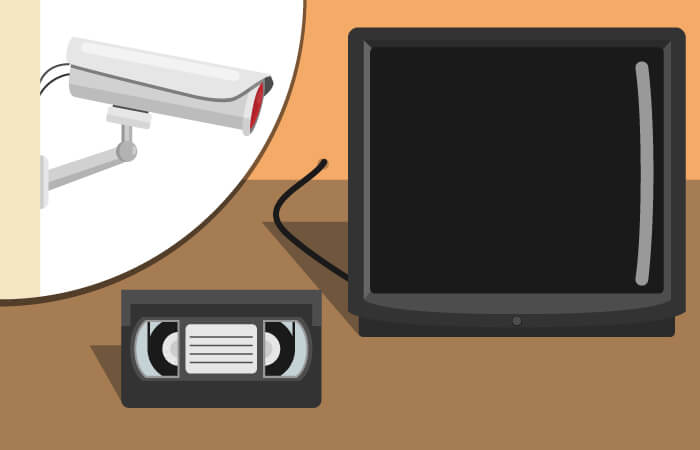
- They are tap-proof
- Transmission is not affected by other wireless devices
Loop recording
Due to the limited storage capacity, many cameras work with the loop method. They record content and overwrite it after a certain period of time (for example, after 72 hours). This has the advantage that you’ll never have to manually delete data to free up some memory space. Some models have a motion detector and automatically save short video sequences if a person enters the surveillance area defined by the user. With other models, such video sequences need to be saved manually.
They are therefore suitable for retail shops as well as for private users who do not want their recordings to be transmitted over the internet.
Network camera: remote access via the internet
The more modern form of security camera, also called an IP camera, enables worldwide remote access via internet-enabled devices such as desktop computers, laptops, tablets, and smartphones. In addition, many devices can connect to existing wireless networks, so there is no need for laying a cable, etc. Only a power supply is necessary. This is a great advantage because you can also access the footage while being away, for example when on holiday. With a bit of luck, you could immediately notice a burglary through the live image transmission and notify the police.
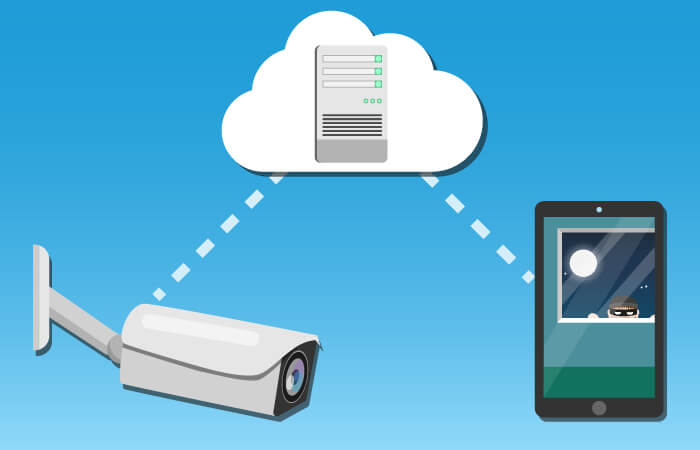
On top of that, the acquisition costs for recording and playback devices are significantly lower. The easiest way to store images or video material is to use a storage medium such as an SD card. The loop mode allows the data to be recorded in an endless loop. A computer is sufficient for viewing the recordings. A network camera is therefore suitable for private users who want to make sure that everything is in order at home while working or on holiday. But such a model is also suitable for the uncomplicated monitoring of a shop.
Additional safety tips
There are a number of things to consider when choosing an installation location. First, the area that you want to monitor should be completely covered by the camera. In addition, you should refer to the manual to determine the maximum distances from the guarded area that must be maintained in order for the motion or face detection to function without problems. As a general rule, a minimum height of about 8 feet is recommended, especially for outdoor cameras, in order to be protected from vandalism by passers-by.
Additional burglary protection: prevention measures
Many people would like to have better protection against burglaries. This especially concerns people who have already been on the receiving end of a break-in before. Many measures are meant to deter burglars and potentially dissuade them. For example, it can be helpful to invest in a bright spotlight with a motion detector in addition to installing a security camera. This is because most burglaries or acts of vandalism take place under the cover of darkness. A guard dog can be just as much of a deterrent. What is more, there is the option of installing special window and door locks that can’t be pried open. The installation of an alarm system can also be considered. For companies, security guards are an option, possibly supported by guard dogs.
The best-known manufacturers of surveillance systems
Abus | Edimax | Foscam | Instar | Nest | Netatmo | Netgear | Reolink | S-Link | Technaxx | TP-Link
Image 1: sabine hürdler / stock.adobe.com | Image 2: © jozsitoeroe / stock.adobe.com ©| Images 3–12: © FinalCheck

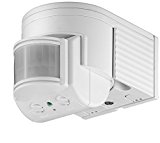
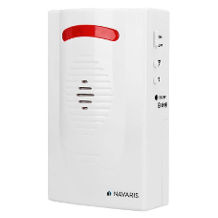
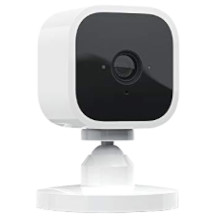
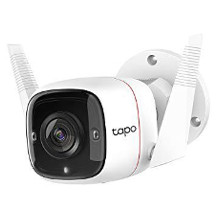
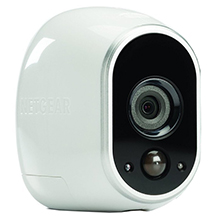
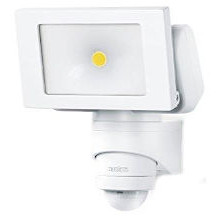
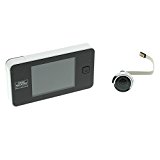
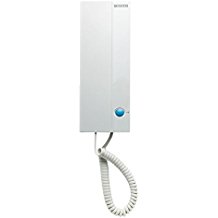
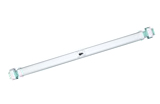
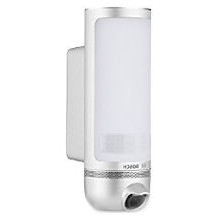
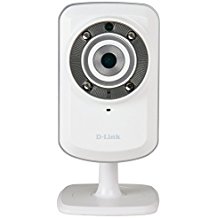
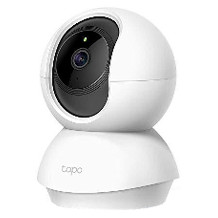
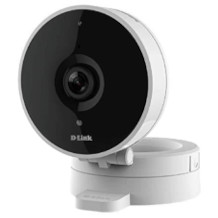
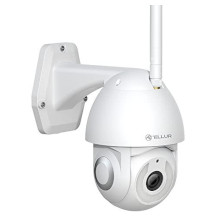
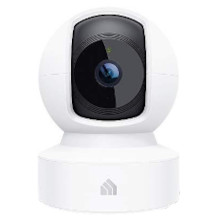

 3,469 reviews
3,469 reviews
